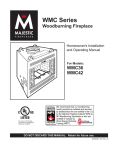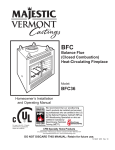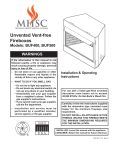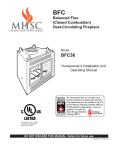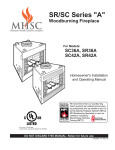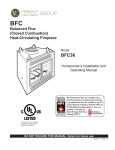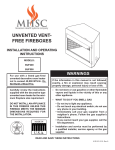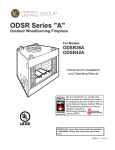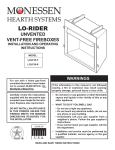Download Monessen Hearth CWC500 Specifications
Transcript
CWC Series Woodburning Fireplaces For Models: CWC400 CWC500 Homeowner's Installation and Operating Manual FP583A WMC 12/18/98 For use in U.S./Canada Underwriter's Laboratories Report No. MH7603 DO NOT DISCARD THIS MANUAL: Retain for future use. 87D1504 12/09 Rev. 4 CWC Series Woodburning Fireplace Safety Information Please read this manual before installing and using FIREPLACE. IMPORTANT: Read all instructions and warnings carefully before starting installation. Failure to follow these instructions may result in a possible fire hazard and will void the warranty. Description The CWC Series fireplaces are solid fuel, woodburning premium fireplaces. The CWC are circulating models with removable grilles (louvers). Both models are fully insulated fireplaces. Precautions MHSC fireplaces and component parts have been highly tested and will operate safely when installed in accordance with instructions provided in this manual. Carefully read and understand all instructions before beginning installation. If you notice any damage to fireplace or component parts, immediately report damage to your MHSC dealer. Only use MHSC components or the warranty will be voided and a fire hazard may be created. MHSC warranty will be voided by and MHSC disclaims any responsibility for the following actions: • Installation by any other than a qualified installer, preferably NFI or WETT (Canada) certified. • Installation of any damaged fireplace or chim- Do not install a solid fuel burning insert or other products not specified for use with this fireplace. Proposition 65 Warning: Fuels used in gas, woodburning or oil fired appliances, and the products of combustion of such fuels, contain chemicals known to the State of California to cause cancer, birth defects and other reproductive harm. California Health & Safety Code Sec. 25249.6 WARNING: Check with your electronics manufacturer before installing a television or other electronic device above this fireplace. Drafts The fireplace should not be located in areas that create drafts (ie: frequently opened doors and central heating air inlets/outlets) that hamper the normal flow of air into the fire. Gas Logs If you plan to install a gas log, the gas line should be installed before framing the fireplace. The gas line must be installed by a certified gas line installer. ney component; • Modification of fireplace, chimney assembly or any component parts thereof; (except for chase flashings as detailed in the Chimney Top installation instructions). • Installation other than as instructed by MHSC; or CWC400 / CWC500 Listed UL 127 / ULC-S610 Standard for Factory Built Fireplaces • Installation and/or use of any component part not manufactured or approved by MHSC in combination or assembly with a MHSC fireplace system, notwithstanding any independent testing laboratory or other third party approval of such component parts or accessory. Any such action may possibly cause a fire hazard. Consult local building codes to ensure that you are in compliance before installing the fireplace. Fireplaces must be vented to the out-of-doors. Do not obstruct or modify air inlets/outlets in any manner. Do not install combustible materials on any of the black fireplace surround. Burn only solid wood fuel or gas logs. Table of Contents Safety Information. . . . . . . . . . . . . . . . . . . 2 Specifications and Framing . . . . . . . . . . . 3 Parts Identification . . . . . . . . . . . . . . . . . . 4 Chimney Requirements . . . . . . . . . . . . . . 5 Planning Information. . . . . . . . . . . . . . . . . 6 Installation . . . . . . . . . . . . . . . . . . . . . . . . 7 Replacement Parts . . . . . . . . . . . . . . . . . 18 Accessories. . . . . . . . . . . . . . . . . . . . . . . 19 87D1504 CWC Series Woodburning Fireplace CWC400 Series Woodburning Fireplace — Circulating Model 22Z\x" (572mm) 8" Dia. (203mm) m ) 22" (559mm) 66 Z\v " ( B\ 16 ," 83 (16 m m m m ) ) Rough Opening Height 36B\," (930mm) B\," Recessed (16mm) Nailing Flange Rough Opening Width 41" (1041mm) 7Z\x" (191mm) 40C\v" (1035mm) Outside Air 7Z\x" (191mm) 19C\v" (502mm) 85 7m 33 C\v "( 47" (1194mm) 11" Dia. (279mm) 8Z\v" (210mm) 36" (914mm) Gas Line Access 14B\," (372mm) 9Z\x" (241mm) 8" (203mm) 3" (76mm) 15C\," (391mm) 35Z\v" (895mm) 47" (1194mm) Z\x" (13mm) Z\x" 22" (559mm) Rough Opening Depth Gas Line Access 21" 7C\v" (197mm) 35Z\x" (902mm) 40" (1016mm) 1C\v" (45mm) Electrical Access FP590A Fig. 1 CWC400 Series specifications and framing. CWC500 Series Woodburning Fireplace — Circulating Model 22" (559mm) 17 B\, 91 " (1 m 6m m m ) ) Z\x "( Rough Opening Height 70 Rough Opening Width 47" (1194mm) 7Z\x" (191mm) 36B\," (930mm) 7Z\x" (191mm) Outside Air Gas Line Access 42" (1067mm) 14B\," (372mm) 9Z\x" (241mm) 8" (203mm) 15C\," (391mm) 3" (76mm) 35Z\v" (895mm) 40C\v" (1035mm) 19C\v" (502mm) m 36 "( 91 4m 50" (1270mm) Z\x" FP590A 13C\," Dia. WMC36 SPECS (340mm) 1/28/99 8" Dia. djt (203mm) 11" Dia. (279mm) B\," Recessed (16mm) Nailing Flange 8Z\v" 22Z\x" (210mm) (572mm) ) 50" (1270mm) Z\x" (13mm) 26Z\v" (667mm) Rough Opening Depth 21" (533mm) Gas Line Access 7C\v" (197mm) 38" (965mm) 46" (1168mm) 1C\v" (45mm) Electrical Access FP592A Fig. 2 CWC500 Series specifications and framing. 87D1504 FP592A WMC42 SPECS 1/28/99 CWC Series Woodburning Fireplace Front WidthBack Width Depth AB C CWC400 33Z\x" 20Z\v" 18Z\v" (851 mm) (514 mm) (464 mm) CWC500 39B\," 23C\," 18Z\v" (1007 mm) (594 mm) (464 mm) B C A FP1531 Fig. 2a Hearth dimensions. FP1531 hearth dimensions Chase Installation 9/04 djt Insulation methods shown are optional for cold climate, not a requirement for unit operation. Termination Cap Storm Collar Pan Flashing Batt Insulation (cut out around firestop) Draftstop Firestop Ceiling Level Top Shield Surround Outlet Grille Standoff Nailing Flange Damper Control Gas Line Access (both sides) Gas Line Knockout (both sides) Screen Electrical Access Grate Outside Air Cover Plate Firebox Metal Safety Strips (1, 2 or 3 pieces) Inlet Grille FPC554 Fig. 3 Fireplace and chase parts identification. 87D1504 CWC Series Woodburning Fireplace Chimney Requirements - Offset Installations OFFSET CHIMNEY FLUE EXIT RISE CHIMNEY SECTION B A D G IWF282 30˚ RETURN ELBOW 30˚ OFFSET ELBOW 30° Elbow Offsets IWF282 G 1' 1¹⁄₂' 3' 4' Chimney Support ELBOW 0 0 0 0 0 1 0 0 0 E RISE 0 1 0 0 6 FT. 2 0 0 0 SKCS8 30˚ C 1 1 0 0 SUPPORT RETURN 0 0 1 0 H ELBOW OFFSET 2 1 0 0 H 0 0 0 1 30˚ 0 1 1 0 B OFFSET 1 0 0 1 ELBOW 0 1 0 1 0 0 2 0 HEARTH FLOOR 1 1 0 1 0 0 1 1 0 1 2 0 Example 1 Example 2 Example 3 0 0 0 2 FPC269 0 1 1 1 Notes: G + H cannot exceed 20 feet. 0 0 3 0 Air Space Clearances: SK8 (2-wall) = 1¹⁄₂" and "S" Series (3-wall) = 2" 0 1 0 2 FPC269 Illustration Key 0 -typ. 0 offset 2 1 Chimney Requirements Circulating models 0 1 3 0 C. The chimney cannot be more than 30° The following safety rules apply to 1/28/99 djt 0 0 1 2 (45° in Canada) from the vertical plane in offset installations (letters correspond 0 1 2 1 any installation*. with illustration above): 0 0 0 3 D. The maximum length of the angled run A. Height of the chimney is measured 0 1 1 2 of the total chimney system is 20 feet. (G from the hearth to the chimney exit. 0 0 3 1 plus H cannot exceed 20 feet.) 0 1 0 3 CWC400 CWC500 E. A chimney support (Model SKCS8, 0 0 2 2 Maximum: 90' 90' TCS8A - 8 inch triple wall) is required 0 1 3 1 Minimum: every 6 feet of angled run of chimney. 0 0 1 3 Without Elbows 12' 6" 12' 6" Chimney supports are required for every 0 1 2 2 With 2 Elbows* 15' 0" 15' 0" 30 feet and 60 feet (SK8 pipe) or 20 feet 0 0 0 4 With 4 Elbows* 21' 0" 21' 0" and 40 feet (3-wall pipe) of vertical chim 0 1 1 3 ney height above the hearth. 0 0 3 2 B. Do not use more than 4 elbows per Determine the offset distance of your 0 1 0 4 chimney. chimney arrangement from the centerline 0 0 2 3 Attach the straps of the return (top) of the fireplace to the centerline of the 0 1 3 2 elbow to a structural framing member. chimney where it is to pass through the 0 0 1 4 The offset (first) elbow of any pair does first ceiling. 0 1 2 3 not have straps. 0 0 0 5 Note: This offset distance may not be your full offset distance. See Examples 2 and 3. * In Canada, two (2) SK845 are allowed. 0 0 0 0 0 0 0 0 0 0 0 1 1 1 1 1 1 1 1 1 1 1 1 2 2 2 2 2 2 2 2 2 2 2 2 3 3 3 3 MBUF 5/26/96 Offset Rise 3" 11" 8¹⁄₄" 20" 11¹⁄₄" 25¹⁄₄" 13¹⁄₂" 29¹⁄₄" 16¹⁄₂" 34¹⁄₄" 20¹⁄₄" 40³⁄₄" 21³⁄₄" 43¹⁄₂" 26¹⁄₄" 51¹⁄₄" 28¹⁄₂" 55¹⁄₄" 31¹⁄₂" 60¹⁄₄” 34¹⁄₂" 65¹⁄₂" 37¹⁄₂" 70³⁄₄" 41¹⁄₂" 77³⁄₄" 45" 83³⁄₄" 47¹⁄₄" 87¹⁄₂" 51" 94" 53¹⁄₄" 98" 56¹⁄₄" 103¹⁄₄" 59¹⁄₄" 108¹⁄₂" 62¹⁄₄" 113¹⁄₂" 64¹⁄₂" 117¹⁄₂" 68¹⁄₄" 124" 70¹⁄₂" 128" 74¹⁄₄" 134¹⁄₂" 78" 140³⁄₄" 81" 146" 84" 151¹⁄₄" 87" 156¹⁄₂" 89¹⁄₄" 160¹⁄₄" 93" 166³⁄₄" 95¹⁄₄" 170³⁄₄" 99¹⁄₄" 177³⁄₄" 101¹⁄₄" 181³⁄₄" 104¹⁄₄" 186¹⁄₄" 107¹⁄₄" 191¹⁄₂" 110¹⁄₄" 196³⁄₄" 114" 203¹⁄₄" 117³⁄₄" 209³⁄₄" 120" 213¹⁄₂" 123³⁄₄" 220" Fig. 4 Chimney system requirements. 87D1504 CWC Series Woodburning Fireplace Planning Information Preplanning an installation is very important to ensure safety and to save time and money. An installer must predetermine where a fireplace will be set and how the chimney system will be run. Mounting the Fireplace A fireplace may be mounted on the following surfaces: 1. A flat combustible surface. 2. A raised wooden platform. 3. A concrete block or other solid object placed beneath each of the four (4) corners of the fireplace. The fireplace must be spaced 1/2" (13 mm) from a combustible back wall and 1/2" (13 mm) from a combustible side wall or support. Refer to Page 14, Figure 18. Planning the Chimney Run Determine how the chimney will be run, length of run and chimney components required to complete the job. (Fig. 4) Never install a chimney below minimum heights. LT L1 L1 TRIPLE WALL 81 818 83 84 MODEL SK TOTAL INSTALLED LENGTH LENGTH 2 WALL (LT) CHIMNEY (L1) SK81 SK818 SK83 SK84 56O" 56O" 56O" 56O" 56O" 56O" 56O" 56O" FP288A The Ten Foot Rule Major U.S. building codes specify a minimum chimney height above the roof top. The “Ten Foot Rule” is a fire safety rule and not a draft rule. It is recommended that you always meet or exceed the “Ten Foot Rule,” especially when installing a termination on a high pitch roof. (Fig. 6) The key points of the "Ten Foot Rule" are: 1. If the horizontal distance from the chimney to the peak of the roof is 10' (3 m) or less, the top of the chimney must be at least 2' (609 mm) above the peak of the roof, but never less than 3' (914 mm) in height above the highest point where it passes through the roof. 2. If a horizontal distance from the chimney to the peak of the roof is more than 10' (3 m), a chimney height reference point is established that is on the surface of the roof a distance of 10' (3 m) from the chimney in a horizontal plane. The top of the chimney must be at least 2' (609 mm) above the reference point, but never less than 3' (914 mm) in height above the highest point where it passes through the roof. 0 To 10’ 2’ Min. 0 To 10’ 3’ Min. 2’ Min. 3’ Min. Reference Point AC246 Fig. 5 Installed lengths of chimney sections. In planning a chimney system, it is important to know: FP288A MBUF-INSTALLED LENGTH 1. The height of a chimney is measured from the Triple wall hearth to the exit point on the termination. 1/28/99 djt 2. A chimney cannot be offset more than 30° from a vertical plane. 3. A chimney may run straight up or it may be necessary to offset it to avoid obstructions. 4. The maximum length of an angled run (total chimney system) is 20' (6 m). 5. No more than 2 offsets (4 total 30° elbows in U.S./ or 2 total 45° elbows in Canada) per fireplace may be used. 6. A guy wire stabilizer (not provided) is required for chimneys extending more than 6' (1.8 m) above a roof line. Fig. 6 Ten Foot Rule illustration. AC246 4/1/96 87D1504 CWC Series Woodburning Fireplace Chimney Supports The chimney system is supported by the fireplace for vertical chimney heights less than 30' (9 m) above the hearth. Chimney supports are required if the vertical height exceeds 30' (9 m) with SK8 chimneys or 20' (6 m) with 3-wall chimneys. Locate chimney supports at ceiling holes or other structural framing at 30' (9 m) (SK8) or 20' (6 m) (3-wall) heights. Spacing between chimney supports must not exceed 30' (9 m) (SK8) or 20' (6 m) (3-wall). Use Chimney Support Model SKCS8 (SK8) and TCS8A (3-wall). (Note: The chimney support cannot be mounted directly to the fireplace.) Support provided by elbow straps fulfills the support requirement only if they are spaced as previously described. (A chimney support is 2¹⁄₂" long when installed.) Angled chimney runs require a support every 6' (1.8 m) in addition to the elbow straps. Chimney supports are used for this function. (Fig. 7) Chase Installation A chase is a vertical boxlike structure which encloses the fireplace and/or chimney. Chases are typically built on the outside of the house with fireplace opening cut into the outer wall of a room. (Page 5, Fig. 3) If you need help in determining fireplace location or how the chimney system should be run, contact your MHSC dealer for assistance. Installation Insulating Fireplace Enclosure for Cold Climates If you live in a cold climate, it is not required but highly recommended that you insulate fireplace enclosure to eliminate cold air penetration as much as possible. Insulate base of fireplace with a noncombustible insulation rated for a minimum of 300°F. Insulating is very important for outside wall installations over a concrete slab. If fireplace is installed on a platform, insulation should be placed on top of the platform before fireplace is set. (Fig. 8) When a fireplace is installed in a chase or on a outside wall, enclosure should be treated like any outside wall in a home. Insulation should be installed on the inside wall as well as the outside wall(s). In a chase, it is also a good idea to install a firestop at the first ceiling level above the fireplace and enclose the chase with sheeting material. Insulation may then be installed above sheeting material to assure the space around the fireplace is totally protected. (Fig. 3) When installing the chimney, DO NOT caulk between outer pipe and firestop. It is vital that some air be allowed to flow through this very thin gap. CAUTION: WHEN INSTALLING A FIREPLACE IN AN INSULATED ENCLOSURE, BE SURE ALL REQUIRED AIR SPACES ARE MAINTAINED. (Page 13, Fig. 18) Cover Plate Top Shield Chimney Support Strap Hard, Flat Surface Chimney Support FP284 Fig. 7 Chimney support installation. FP284 MBUF CHIMNEY SUPPORT 1/28/99 djt Insulation Platform FPC555 Fig. 8 Insulating between platform and fireplace. 87D1504 FPC555 Platform insulation circulating model 1/28/99 djt CWC Series Woodburning Fireplace Framing Frame fireplace with 2 x 4 lumber or heavier materials. Refer to framing dimensions in Figures 1 and 2 for basic fireplace specifications. Ground White Framing can be constructed before or after the fireplace is set in place, however, most installers build the frame before setting the fireplace. Ground Screw Black Wall Junction Box (not supplied) Variable Speed Control (optional) NOTE: Framing should be positioned to accommodate wall covering and fireplace facing material. IMPORTANT: To prevent electrical shock, the house power must be disabled. This can be accomplished by positioning the circuit breaker to off. The fan kit assembly and model EB1 junction box are factory installed. NOTE: Check local building codes to determine if a junction box is required at the romex pigtail/house wire connection. Ground Stud Black CAUTION: ALL WIRING SHALL BE DONE BY A QUALIFIED ELECTRICIAN AND SHALL BE IN COMPLIANCE WITH ALL LOCAL, CITY AND STATE BUILDING CODES. Green Install Electrical Connection White Wire Nuts (supplied) Receptacle Fireplace Junction Box FP1212 Fig. 9 SCVS wiring diagram. Electrical Box (not supplied) FP1212 SCVS wiring Speed Control 5/23/02 djt Install Variable Speed Control The SCVS Variable Speed Control is tested and safe when installed in accordance with these instructions. Read all instructions before beginning installation. Follow instructions carefully. The SCVS speed control may be used as an alternate wall switch in lieu of the single pole (Listed 1.5 Amp 120V) switch described in the fan or fireplace installation instructions. Installation Instructions For mounting the speed control, a 2" deep standard electrical box should be used. Using wire nuts supplied with the speed control, connect control in series with fan motors and line voltage. Refer to Figure 9 for wiring diagram. Mount speed control in electrical box and attach wall plate with screws provided. Push on knob so that indicator is in OFF position. (Fig. 10) Cover Plate Oval Head Screw OFF Flat Head Screw Wire Nut LOW Plastic Knob FP1213 Fig. 10 Speed control mounting. FP1213 SCVS components 5/24/02 djt Operation Turn control knob counterclockwise until a click is heard for OFF position. To operate fans, turn knob clockwise and adjust fan speed as desired. 87D1504 CWC Series Woodburning Fireplace Chimney Set-up Since you have already preplanned the chimney run, you should know exactly how the installation is to be accomplished - how much pipe is required, the number of elbows, if any, and type of termination to be used. CAUTION: REPORT TO YOUR DEALER ANY PARTS DAMAGED IN SHIPMENT, SPECIFICALLY CHECK THE END CONNECTION OF CHIMNEY SECTIONS AND ELBOWS. NOTE: The CWC400 may use MHSC model SK8, or Model S (three wall) chimney systems. However, a TWABR adapter collar is required when using the Model S (triple wall) chimney system on this unit. The CWC500 is designed to use only the "S" triple wall chimney system. Either chimney system may be used, but must not be mixed. Chimney Centerline Actual Centerpoint 9 Z\v" (235mm) Plumb Line Plumb Bob Imaginary Centerpoint NOTE: To use the TWABR adapter on the CWC400, remove and discard the cover plate on the top shield. (Fig. 8) Straight-Up Chimney Installation To mark the centerline of the flue, put the fireplace in final position and measure out from the wall: 9¹⁄₄" (235 mm). Mark a spot on the ceiling directly above the fireplace. Draw a line parallel to the back wall through this mark. (Fig. 11) Using a plumb bob positioned directly over center point of fireplace flue collar, mark the ceiling to establish the chimney center point. (Fig. 11) Offset Installation In order to clear an obstruction, it may be necessary to offset chimney from vertical. This is accomplished by using MHSC elbows. Use the 30° Offset Elbow table on Page 5 to determine proper offset and parts required. Each offset requires two (2) elbows. The second elbow is equipped with support straps. It is very important to install the second elbow in each offset as close to the ceiling or support as possible so the elbow straps can be secured to framing members to help support the weight of the chimney. Determine offset distance of your chimney arrangement from centerline of fireplace to centerline of chimney where it is to pass through ceiling. Locate center point of the chimney on ceiling as though a straight up chimney arrangement is to be used. Measure your offset dimension from straight up chimney center point on ceiling. 87D1504 FPC556 Fig. 11 Locate centerline of chimney with plumb line. Ceiling Chimney Hole/ Possible Obstructions The size of the hole in ceiling will vary with the angle at which the chimney passes through ceiling. Drive a nail up through ceiling at marked chimney center point. Go to floor above and seeFPC556 where hole will be cut. WMC Check to see where existing ceiling joistsCENTER and other posLOCATE LINE sible obstructions are located...i.e. wiring, plumbing etc... Circulating model djt If necessary, reposition chimney1/28/99 and/or fireplace to avoid obstructions. Cutting the Hole Cover fireplace collar opening and cut proper sized chimney hole in chimney. The SK8 pipe allows you to run pipe through a typical 16” on center joist without cutting joists. CWC Series Woodburning Fireplace Framing the Ceiling Hole Frame the ceiling chimney hole as shown in Figure 13. It is good practice to use framing lumber that is the same size as the ceiling joists; this is a requirement at attic level. Metal Safety Strips (1, 2 or 3 Pieces) The following table gives firestop spacer model numbers: Angle of Chimney at Ceiling Size of Chimney Vertical 30° 8" Flue SKFS2A SKFS6A "SK" Series 14¹⁄₂" x 14¹⁄₂" 14¹⁄₂" x 25¹⁄₂" (368mm x 368mm) (368mm x 648mm) 8" Flue FS2A FS6A "S" Series 3-Wall 17¹⁄₂" x 17¹⁄₂" 17⁷⁄₈" x 29⁵⁄₈" (445mm x 445mm) (454mm x 753mm) Fig. 12 Ceiling chimney hole sizes necessary for installing firestop spacer. The inside dimension of the frame must be the same as the hole size selected from Figure 13 in order to provide required air space between the outside diameter of the chimney and the edges of the framed ceiling hole. (1¹⁄₂" - SK8; 2" - 3 wall) Existing Ceiling Joists See See Fig. 12 Fig. 12 Chimney Hole FirePlace "Z" Safety Strip (not supplied) 1Z\x" Z\x" (13mm) Min. Overlap PlatForm Hearth Ext. FPC557 (38mm) Fig. 14 Safety strip installation. Safety strips are used to ensure that any combustible materials in front of the fireplace are protected even though a noncombustible hearth extension is required. If fireplace is to be elevatedFPC557 above the floor, a “Z” shaped metal safety strip must be fabricated and used WMC Safety strip installation to protect combustible surfaces in front of the fireplace. models This “Z” shaped safety stripcirculatin is not provided but must be 1/29/99 fabricated of metal with each horizontaldjt leg at least 1¹⁄₂" (38 mm) wide and equal in length to the metal strips provided with the fireplace. Note: Safety strips are not required over noncombustible floors where all supports at the base of the fireplace are noncombustible. Nailing flanges are integrated on the face of the fireplace. To level the box and secure it firmly in place, bend the nailing flanges and install as shown in Figure 15. Ceiling Nail Top Standoffs New Framing Members FP551 Fig. 13 Typical frame for ceiling chimney hole. Positioning, Safety Strips, Securing The WF551 Fireplace Slide fireplace into position. Lift the fireplace front slightly and slide the metal safety strips under front bottom edge about 1¹⁄₂" (38 mm), allowing the remainder to extend in front of firebox. Overlap strips at least 1/2" (13 mm) to provide a positive joint. (Flat safety strips are packed with fireplace.) (Fig. 14) 10 Nail SideNailing Flanges BR/BC 9/29/97 FPC549 Fig. 15 Fasten fireplace in position. FPC549 Nail flange/standoff circulating models 1/29/99 djt 87D1504 CWC Series Woodburning Fireplace Installing Outside Air Kit Inner Pipe Section An outside air kit is installed in all CWC Series Fireplaces. If desired, or if local codes mandate the use of an air kit, then an AK-MST is required to complete the installation (from air kit to the outdoors). If the outside air kit is to be used, the AK-MST MUST be installed BEFORE the fireplace is enclosed. Refer to the AKMST instructions for field installation. The outside air control lever is located at the front edge of the left side brick. To ‘open’, push the control lever down toward the hearth brick. To ‘close’, pull the control lever up and over. (Fig. 16) Pipe Rim UP Hem Lance Pipe Rim FPC558 Fig. 17 Install pipe, listening for the snap-lock to fasten. Elbow Strap CLOSED Support Structure N OPE Elbow Strap (Must be tight) FP710 Fig. 16 Outside air operation. 710 InstallingWF the Chimney System OUTSIDE AIR LEVER WOOD FIREPLACES Angled Strap 5/28/98 Start by attaching the first chimney section to the collar on top of the fireplace. Install the pipe as pictured in Figure 17. When you get a good lock, you will hear the pipe clearly snap together. Once sections are snap-locked in place, it is extremely difficult to get them apart. Make sure the pipe is firmly snapped and locked together as each pipe section is mounted. When installing elbows, only outer pipe will snap- lock. Middle pipes simply slide into position. Be sure to always attach straps on upper elbow to a structural framing member. (Fig. 18) Continue installing the pipe as required until pipe is installed up through the ceiling. At this point, you must install a firestop spacer. Installing the Firestop Spacer in the Ceiling Hole A firestop spacer is used to keep pipe spaced properly and required for safety. Nail the firestop spacer (at each corner) to the framing members of the ceiling hole. NOTE: A firestop spacer is not required at the roof. 87D1504 Ceiling Hole Framing FPC558 WMC Pipe install Circulating models 1/29/99 djt Angle Firestop FP270/271 Chimney Support Strap (Must be tight) FP270/271 Fig. 18 Attach straps to a structural framing member. CR Series 2/19/99 djt Hole sizes listed in Figure 13 for angled firestop spacers provide minimum required air space to chimney pipe for ceiling thickness up to 8" (203 mm). When combined thickness of ceiling material, ceiling joists and flooring material exceeds 8" (203 mm), adjustments must be made in framing to assure that minimum air spaces to chimney are maintained. Proper Firestop Spacer Installation Figure 19 shows different installation procedures for both an area that is an attic and an area that is not an attic. If the area above the ceiling is not an attic, position the firestop spacer with the flange on the ceiling side and the angled portion extending up into the hole. If the area above the ceiling is an attic, position the firestop spacer with the flange on the top of the framed 11 CWC Series Woodburning Fireplace Attic Installation Nails (4) Firestop Spacer Attic Insulation Shield Nails (4 required) Joist NOTE: If the attic insulation shield is used, the firestop is not required in the attic installation. Attic Joist Ceiling Installation Ceiling Base Flanges FP263 Joist Fig. 20 Attic shield installlation (Canadian requirement). Continue Installing Pipe to Complete Run Firestop Spacer Nails (4) FP593 Fig. 19 Installing firestop spacer. hole and the angled portion extending down into the FP593 hole. SR/C Firestop spacers 11/20/97 are not available for nor are they required on vertical walls. DO NOT put any sealant around the area where the outer pipe slides through the firestop spacer. If you seal this area, it may cause a fire hazard. Canadian Requirements for Insulation Shield In Canada, an attic insulation shield is required to prevent attic insulation from contacting the chimney section. NOTE: If the attic insulation shield is used, the firestop is not required in the attic installation. Framing dimensions for the chimney hole should measure 14¹⁄₂" x 14¹⁄₂" (368 x 368 mm) for SK8; 17¹⁄₂" x 17¹⁄₂" (445 x 445 mm) for 3-wall. An attic shield MUST be installed on top of attic joists (above the floor level). (Fig. 20) NOTE: In the U.S., it is a good idea, although not always required, to install an attic insulation shield where blown-in insulation is planned to be used in the attic. Install the attic insulation shield with the flanges on its base extending down into the framing hole. Nail each corner of attic insulation shield to the framing members of the ceiling hole using 8d nails. Attic shields are not required at the roof. 12 Continue attaching pipe sections to complete system IGF263 MBUFis firmly to next level always being careful that the pipe snapped locked in place before proceeding5/9/96 to next pipe section. Chimney Supports If chimney supports are required, they are installed the same as elbows. Nail chimney support straps to adjacent structural framing, as shown on Page 7, Figure 7. Bend straps as necessary and make sure they are secure so they will support the weight of the chimney. A chimney support is 2¹⁄₂" long when installed. Consider this dimension when determining how many straight chimney sections are needed. NOTE: Chimney supports are generally used in long runs in a chase installation. Additional Ceilings If you encounter additional ceilings, repeat same steps required for first ceiling installation. Refer to firestop illustration on Figure 19. Penetrating the Roof Run pipe to roof line. Since chimney system must be vented to the out-of-doors, you must use an approved termination. If a chase is used, refer to the installation manual provided with the termination cap. Locate Chimney Centerpoint On Roof Use same procedure detailed in locating center point of the flue system. Drive a nail up through roof at the center point. This will determine center point on outside of the roof. 87D1504 CWC Series Woodburning Fireplace Cut and Frame Roof Hole Air Space Clearances Size of roof hole varies with the type of chimney termination installed. Refer to installation instructions provided with the chimney termination to find correct size of roof hole. There must be an air space (1¹⁄₂" - SK8; 2" - 3-wall) between outermost portion of chimney sections and any adjacent combustible surfaces. (Combustible surfaces include burnable materials such as: ceiling members, joists, flooring, combustible insulation and roof structures.) WARNING: DO NOT PACK REQUIRED AIR SPACES WITH INSULATION OR OTHER MATERIALS. Mark an outline of the roof hole around the center of the point nail. Note: Hole dimensions given in the chimney top installation instructions are horizontal dimensions; therefore, the hole size must be marked on the roof accordingly. Cover the opening of the installed chimney so debris cannot get into the system. Cut and frame the hole. It is good practice to use framing lumber that is the same size as the rafters. Install the frame securely because the chimney top and flashing anchored to the frame must be able to withstand heavy winds. Combustible framing material MUST NOT penetrate AIR SPACE (shaded areas). 1Z\x" (SK8) 2" (3-wall) Standoff Z\x" Air Space To Sides Front View Side View Firestop Wall Shield Z\x" Air Space to Back Z\x" Air Space to Sides Install Remainder of Chimney Sections Since you have already preplanned the height of your termination according to the Ten Foot Rule, continue to install pipe to the predetermined height. Check the chimney top installation instructions for details on how high above the roof top the chimney sections (all pipes) should extend. Installing Top Housing or Termination Follow the installation instructions provided with the chimney termination you have selected. Installing Chimney In a Chase Refer to Page 4, Figure 3 for an illustration of a typical chase installation. CAUTION: Treatment of firestop spacers and construction of chase may vary with type of building. These instructions are not a substitute for local building codes. You must check your local building codes to determine specific requirements for your city or state. Note: Other building materials may be required in addition to Firestop Spacers. 87D1504 Only noncombustible material may be applied as facing to the black fireplace surround. 0" Clearance to Floor Hearth Extension FPC559 Fig. 21 Minimum clearances to combustibles. Finishing FPC559 CAUTION: All joints between the finished wall and WMC the fireplace surround (top/sides) must be sealed with AIR SPACES noncombustible material prevent cold air leakage into circulatingtomodels the room. Only noncombustible material may be applied 1/29/99 djt to the facing of the fireplace surround. (Black painted area) (Fig. 21) Finish Wall Finish the wall with material of your choice. Do not install a combustible mantel shelf less than 12" (305 mm) from top of grille opening. Do not install a mantel face plate less than 6" (159 mm) from top of grille opening. (Fig. 23) If a combustible material is 13 CWC Series Woodburning Fireplace Combustible Mantel and Trim 12" (305mm) Max. used below a flat mantel shelf, consult your local building codes for minimum clearance from top of fireplace opening to bottom of mantel shelf. Finished Wall Header 1Z\x" (38mm) Standoff Noncombustible Material 12" (305mm) Min. 6" (159mm) Min. Grille Opening Z\x" Fireplace Front Side Wall Protection 2 x 4 Stud Finished Wall Must be sealed with noncombustible material NOTE: No side wall protection is required for fireplaces installed at 45° to two (2) side walls (corner installation). Often a decorative surround or vertical portion of the mantel is desired. If this is constructed of any combustible material it must be within the safe zone indicated in Figure 23. Fireplace Opening Top View All joints (top, bottom and sides) where wall or decorative facing material meets fireplace surround must be completely sealed with a noncombustible material. (Figs. 22 and 23) FP531b Fig. 22 Mantel clearance. FP531b mantel clearances 9/03 djt Adjacent combustible side walls that are within the minimum dimensions shown in Figure 24 of fireplace opening must be protected with MHSC Wall Shield Model SP40 or a specifically built wall shield described below. The special wall shield design described in Figure 19 is an alternate method of adding protection to side walls and can be used in place of the SP40 with the same wall clearances specified for the SP40. Rt must =1.85 minimum. Face Plate * 1Z\x" Ref. 12" from toptop of of grille opening forfor circulating * 12" from grille opening circumodels lating models 6" from top of grille opening for circulating ** 6" from top of grille opening for circumodels lating models ** Combustible materials are permitted within a shaded area shown in Figure 23 titled Minimum Wall Clearances. MA81 Fig. 23 Combustible mantel clearances. 87D1504 14 MA81 CWC Series Woodburning Fireplace Secure the hearth extension to the floor to prevent shifting, using trim molding or other similar means at three (3) outer edges. Seal crack between the fireplace hearth and hearth extension with a noncombustible material. (Figs. 22 and 26) 1. Manville - CERAFORM 126, K=.27, 1/2 inches thick 2. MHSC - EH2416, K = .458, 1 inch thick required. Hearth Installation A hearth extension is required to protect a combustible floor in front of the fireplace. Refer to Figure 24 for minimum dimensions and mounting detail. NOTE: Hearth Extension must not cover the air inlet/outlet opening of a fireplace. The hearth extension described in Figure 24 must be a durable noncombustible material with a minimum (total) Rt value of 1.09; refer to Figure 25 for examples. The overall height (above a combustible floor), depth and width must be as indicated, with the extension centered to the fireplace opening. The top of insulation must be covered with a noncombustible decorative covering or a piece of .018” minimum sheet metal, to protect hearth extension material. (Fig. 24) FIREBOX OPENING E A - Min. clearance to combustible perpendicular wall SIDE WALL Noncombustible material with a lower R value may be used, provided thickness of material is sufficiently greater to maintain an equivalent (total) thermal resistance (Rt). Shaded area starts 1/2" away from edge of unit 4" F** C** T = given thickness R = thermal resistance for a given thickness (T) K = thermal conductivity (for On-Site Construction) WITHOUT Noncombustible Surround Facing 4" BRICK (Example material) E Alternate noncombustible materials may be used providing the (total) thermal resistance (Rt value) of the alternate material employed is greater than or equal to R = 1.09. Thermal resistance (R) or thermal conductivity (K), may be obtained from manufacturer of the material. Factors are related by the formula K = 1/R. Minimum Hearth Extension Dimensions Minimum Wall Clearances WITH Noncombustible Surround Facing WARNING: HEARTH EXTENSION MUST BE INSTALLED IN ACCORDANCE WITH FIGURE 24 AND MUST NOT COVER THE BOTTOM FRONT OPENING OF THE CIRCULATING MODEL. D SIDE B - Min. clearance WALL to combustible perpendicular wall when using noncombustible wall shield* Combustible material permitted within shaded area. Noncombustible wall shield requires 1" MHSC EH2416 * insulation (minimum R Value = 1.85) between decorative noncombustible rigid covering and combustible wall. Minimum height and width is 40" x 40". ** Dimension/degree of angle will vary depending on thickness of noncombustible surround facing. CWC400 CWC500 H G G J May install noncombustible decorative covering OR .018" min. sheet metal Seal cracks between the fireplace and hearth extension with noncombustible material FIREPLACE HEARTH 4" MIN. COMBUSTIBLE FLOOR MINIMUM INSULATION VALUE "R" Safety strips must overlap 56O" minimum AB C DE FG H J 16" 12" 48° 41° 18" 14" 7³⁄₄" 16" 48" 406 mm 305 mm 457 mm 356 mm 197 mm 406 mm 1219 mm 20" 12" 42° 35° 18" 14" 11¹⁄₂" 20" 61¹⁄₂" 508 mm 305 mm 457 mm 356 mm 292 mm 508 mm 1562 mm Fig. 24 Combustible side wall protection and hearth extension dimensions. FP594A WMC combustible min. 87D1504 1/29/99 djt FP594A 15 CWC Series Woodburning Fireplace COMMON MATERIALS AND FACTORS MATERIAL EH2416 (MHSC) K* R 0.458 1.09 Common Brick 5.0 0.10 MINIMUM THICKNESS Wall Covering Noncombustible Decorative Facing 0.50 in.** 2 x 4" Header Do not notch at standoffs. Seal all cracks between fireplace surround and wall materials with noncombustible material. 5.46 in.** R Value is for 1/2 inch. * Units of K = BTU/SQ FT/HR/˚F/IN ** Thickness of Listed Material FP533ADD Noncombustible Decorative Covering Fig. 25 Hearth extension material factors. Example of Determining Hearth Extension FP533ADD Equivalents Addendum 6/1/99 (per djt inch) thickness NEW K of new material 8/4/99 changed .2 to .1 required = ------------------------------------ X of listed thickness K of listed material inch) one inch(per to 1/2 inch djt material To determine the thickness required for any new material: Example for Common Brick T (new) = 5.0 / 0.458 x 0.50 in. = 5.46 in. (new required thickness). 16 Hearth Extension Insulation Side View Seal crack between fireplace and hearth extension with noncombustible material. Safety Strips Must be overlapped Z\x" minimum. FP550 Fig. 26 Sealing gaps. FP550 BR/BC - SEALING DETAILS 9/29/97 87D1504 CWC Series Woodburning Fireplace Installing Line for Gas Logs MHSC fireplaces are designed to accept a 1/2" gas line for installation of an approved gas appliance. (MHSC manufactures a wide variety of gas logs for use in MHSC fireplaces.) Be sure to have the appliance installed in accordance with building codes. Gas connection may enter from either left or right side of the fireplace. Locate appropriate gas line access hole in the outer casing of fireplace and remove insulation from gas line tube. (Fig. 27) From inside the fireplace, locate the knockout on the firebrick -- be sure you are on the appropriate or "gas line" side of the fireplace. Using a flat bladed screwdriver or small chisel and hammer, carefully tap around the knockout until it loosens and falls out. Install 1/2" certified gas pipe through opening. After gas pipe installation is complete, use insulation that was removed from gas line tube to repack space around the pipe. Material should be inserted from outside of the fireplace and packed tightly to totally seal between the pipe and tube. Note: Gas pipe should not come in contact with any wood structures until it has reached a point at least one (1) inch away from fireplace side. NOTE: When installing an ANSI Z21.11.2 ventless appliance, the finishing materials used for the mantel must be rated at 250°F or greater. BTU input of a gas appliance installed in fireplace should be rated less than 100,000 BTU/Hr. Gas pipe installation is intended for connection to a decorative gas appliance only when (1.) incorporating an automatic shut-off device and (2.) complying with the Standard for Decorative Gas Appliances for Installation in Vented Fireplaces (ANSI Z21.60) or CSA draft requirements for Gas-Fired Log Lighters for Woodburning Fireplaces (Draft No. 4, August 1993). Fireplace Top View Hole in Outer Casing Gas Line Tube 1" Min. Supply Line Ceramic Knockout Repack Insulation 1/2" Hole in Outer Casing Ceramic Knockout (Both sides) FPC560 Fig. 27 Gas line access. FPC560 WMC Gas line access CAUTION: WHEN USING DECORATIVE GAS AP1/29/99 PLIANCE, FLUE DAMPER MUST BE SET IN FULLY OPEN POSITION. IF YOU HAVE GLASS DOORS ON THE FIREPLACE, THEY MUST ALSO BE FULLY OPENED. WARNING: DO NOT OPERATE AN UNVENTED GAS LOG SET IN THIS FIREPLACE WITH THE CHIMNEY REMOVED. WARNING: WHEN INSTALLING AN UNVENTED GAS LOG SET, THE MHSC MODEL CABL OR CABR 4" ADJUSTABLE HOOD MUST BE USED. Decorative gas appliance should be installed in accordance with the National Fuel Gas Code, ANSI Z223.1/ NFPA 54 (latest edition). If installing an unvented gas log set, refer to statement below: Only unvented gas log sets which have been found to comply with the Standard for Unvented Room Heaters, ANSI Z21.11.2, are to be installed in this fireplace. 87D1504 17 CWC Series Woodburning Fireplace 1 6 2 5 7 10 8 11 9 4 12 2 3 13 16 17 18 15 OFF LOW 14a,b MHSC reserves the right to make changes in design, materials, specifications, prices and discontinue colors and products at any time, without notice. 2-583 Parts page 3/2/99 djt CWC400/500 Woodburning Fireplace Item/Model Number 1. Damper Blade CWC400 7551310 CWC500 7551310 2. 3. 4. 5. 6. 7. 8. 9. 10. 11. 12. 13. 14a. 14b. 15. 16. 17. 18. Grille Painted (two per fireplace) Basket Grate Screen (two per fireplace) Damper Knob (Wood) Firebrick - Left Side Firebrick - Back Firebrick - Right Side Firebrick - Hearth Screen Rod (two per fireplace) Top Brick Retainers (three per fireplace) Cable Clips (four per fireplace) O.S.A. Assy. Door Assy. - Brass Doors Door Assy. - Black Doors Door Track Assy. Closure Spring Blower Assembly Variable Speed Control 20014533 3041130 26D0131 7536177 3041104 3030102 3041105 3041103 26D0138 3030172 7512135 20003076 20002984 20005309 20003384 7540264 20000620 2544900 20000714 3041130 26D0131 7536177 3034102 3034104 3034103 3034105 61D0500 3030172 7512135 20003076 20002985 20005310 20003435 7540264 20000620 2544900 18 87D1504 CWC Series Woodburning Fireplace Accessories The following accessories for this appliance are available from your local distributor. Should you need additional information beyond what your distributor can furnish, contact: MHSC, 149 Cleveland Drive, Paris, KY 40361; Attn: Technical Services. CAUTION: This fireplace and chimney assembly is a highly engineered system, and, as such, must be operated only with MHSC approved components. If you use an unapproved component to make any modifications, you may create a possible fire hazard and will void the MHSC warranty. In addition, such action may void the coverage provided by the owner’s insurance. Accessory Glass Door — Optional Description Bi-Fold door set Brushed Brass finish Deluxe Polished finish Pewter finish Outside Air Termination Completes connection from air kit to out-of-doors Chimney Adapter Converts CWC400 to use 3-wall system Hearth Extension Insulation Provides hearth extension floor protection Hearth Patch Compound Patch cracks in hearth OGWMC36 Optional brass trimmed, black mesh grille OGWMC42 Optional brass trimmed, black mesh grille Model Number 36GDKBB (CWC400) 42GDKBB (CWC500) 36GDKDP (CWC400) 42GDKDP (CWC500) 36GDKS (CWC400) 42GDKS (CWC500) AK-MST TWABR EH2416 HPC-1 20000945 (CWC400) 20000946 (CWC500) Contact your Monessen distributor or dealer for finishing Mantels, available in a wide selection of styles. 87D1504 19 CWC Series Woodburning Fireplace Chimney Components U.S. Component Description Model Number Top used to terminate chimney at roof. RLTSK8 (SK8) (Flashing not included.) Round Top Termination - Top used to terminate chimney at chase. RLTSK8L Extended (SK8) (Flashing not included.) Flashing Metal finishing required around Contemporary 8-6-12 with 8" flue: Termination to prevent rain leakage. 0-6/12 pitch 8-12-12 with 8" flue: 6/12-12/12 pitch Square Top Housing Top housing of simulated brick pattern S20BR(Red) available in red, tan or white. Appropriate S20BT(Tan) adapter required. Flashing included. S20BW(White) Housing Extensions Extends Square Top Housing on steep pitched 202036 roofs. (Specify red, tan or white) Square Shroud Square knockdown shroud for RLTSK8L SKDSBL (SK8) chase applications. (Black) Square Chase Termination Housing used to terminate chimney through CT100 a chase top. (Unpainted finish)Appropriate adapter (CTSK) required.(Flashing not included.) Pyramid Shroud Pyramid knock-down shroud for RLTSK8L PKDSBL chase application. (Black) Chase Top Housing Low profile pyramid-style chimney cap used to PLTSK8 (SK8) terminate chimney through a chase. Includes adapter. (Flashing not included.) Chase Top Housing Square chimney cap used to terminate chimney SLTSK8 (SK8) through a chase. Includes adapter. (Flashing not included.) SK8 Chimney Sections Pipe used to build 8" (SK8) flue systems. SK81 (1' Long) SK818 (1¹⁄₂' Long) SK83 (3' Long) SK84 (4' Long) SK8 Chimney Elbows Elbow used to create an offset in an 8" SK830-2 chimney system. Only 30˚ elbows available. Packaged 2 per carton (offset and return). Firestop Required at each floor level of chimney SKFS2A — (SK8) installation. (Plus attic on multi-story installation.) (8" straight flue) SKFS6A — (8" 30° inclined flue) Chimney Support Used to support chimney for each of: 30' vertical SKCS8 (SK8) height and 6' of angled chimney run. Chimney Sections Pipe used build 8" (3-wall) flue systems. 81 (1' Long) (3-wall) 818 (1¹⁄₂' Long) 83 (3' Long) 84 (4' Long) Chimney Elbows Used to create an offset in an 8" chimney system. 830A-2 (3-wall) Only 30° elbows available. Packaged 2 per carton (offset and return). Round Top Termination Top used to terminate chimney at roof. RLTS8 (3-wall) (Flashing not included) Round Top Termination Top used to terminate chimney at chase. RLTS8L Extended (3-wall) Adapter kit included. (Flashing not included) Round Top Termination 20 87D1504 CWC Series Woodburning Fireplace (Chimney Components con't.) Component Description Model Number Square Chase Termination Square chimney cap used to terminate chimney SLTS8 through chase. Includes adapter. (Flashing material) Adapter Kit Required to unite 3-wall chimney with S20BR, S20UB S20BT, S20BW Traditional Top Housing Chimney Support Used to support the chimney at each 30' of TCS8A of vertical height above the hearth and at every 6' of inclined chimney run. Each support adds 2¹⁄₂" to chimney length. Firestop Required at each floor level and attic on FS2A (8" straight flue) multi-story installation. FS6A (8" 30° inclined flue) Radiant Shield Used as an alternate to FS2A firestop to RS-8A reduce the clearance from the chimney to combustible framing. With 16" center lines. Attic Insulation Shield Used to prevent attic insulation from FS2100-HT (3-wall) (CF-11) contacting the chimney system. Canada Chimney Collar Enclosure Installs on the "over the chimney collar" of the CCE-SK (SK8) fireplace; provides outside air to assist in cooling the chimney system. Attic Insulation Shield Used to prevent insulation from coming in AIS-SK (SK8) contact with the chimney system. SK8 Chimney Sections Used to build chimney systems exposed above SK818CAN (1¹⁄₂' Long) roof. SK84CAN (4' Long) 45˚ Chimney Elbows Provides 45° offset and return. For Canadian SK845/2 installations only. For use with SK8 chimney only. (Maximum use of 2, or 1 pair.) Chimney Sections Used to build chimney systems exposed above 8" flue (3-wall) roof. 818CAN (1¹⁄₂' Long) 84CAN (4' Long) Attic Insulation Shield Used to prevent attic insulation from FS2100-HT (3-wall) (CF-11) contacting the chimney system. 87D1504 21 CWC Series Woodburning Fireplace 22 87D1504 CWC Series Woodburning Fireplace LIMITED WARRANTY Factory-Build Fireplace and Components (Except Blowers) What is Covered and For How Long Five-Year Coverage: For five years from the date this fireplace and components are first purchased for use, MHSC will, at its option, repair or replace any defective part of this fireplace or components, or refund to you a sum not to exceed the factory retail price in effect at the time of purchase. Ten-Year Coverage: From the sixth through the tenth year following the date this fireplace or accessory is first purchased for use, MHSC will make available to you, at our factory, a free replacement for any defective part in this fireplace or accessory. Twenty-Five-Year Availability of Replacement Parts: From the eleventh through the twenty-fifth year following the date this fireplace or accessory is first purchased for use, MHSC will make available at our factory replacement parts for this fireplace or accessory, which you may purchase for the list price current at the time your purchase order is received. What is Not Covered • • • • • • • • • • • This limited warranty does not cover: Transportation or shipping cost. The cost of a service call to diagnose trouble. Painted surfaces. Damage or defect caused by improper installation, accident, misuse, abuse or alteration. Poor ventilation of smoke or gases caused by air-conditioning and heating systems, exhaust fans, or pressure differentials produced by wind. Broken glass components. Cracks in ceramic and castable parts that do not affect safe operation. We do not warrant this fireplace to be in compliance with your local building code. Building codes vary greatly throughout the country, and you should determine whether your local building code contains restrictions on the use of this fireplace before you purchase it. Blowers or fans, which are warranted separately. Heat loss due to the passage of heat or air through or around the fireplace. Also, under our five year coverage, we do not pay the cost of removal and replacement of any portion of the structure in which the fireplace is situated, made necessary by the repair, removal or re-installation of the fireplace. And under our twenty-five year warranty of availability of replacement parts, we only promise to maintain a supply of replacement parts at our factory for you to purchase. Limitations and Exclusions 1. No one has authority to add to or vary this limited warranty, or to create for MHSC any other obligations of liability in connection with this fireplace and accessory. 2. MHSC shall not be liable for incidental, consequential, special or contingent damages you might suffer as a result of its breach of this written warranty or any implied warranty. Some states do not allow the exclusion of limitation of incidental or consequential damages, so the above limitations may not apply to you. 3. This warranty applies only to a fireplace sold and used in the United States. For information about this warranty, contact: MHSC 87D1504 149 Cleveland Drive Paris, Kentucky 40361 23 MHSC 149 Cleveland Drive • Paris, Kentucky 40361 www.mhsc.com
























